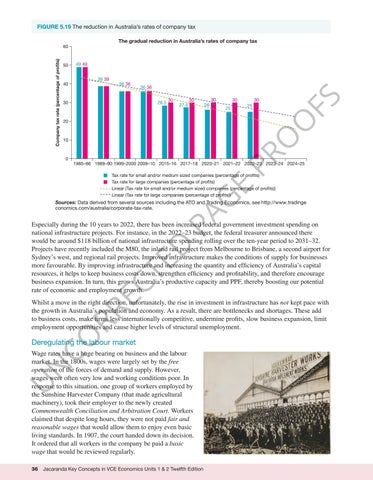“c05TheChangingLabourMarket_PrintPDF” — 2022/6/3 — 13:15 — page 36 — #36
FIGURE 5.19 The reduction in Australia’s rates of company tax The gradual reduction in Australia’s rates of company tax
50
49 49 39 39 36 36
36 36 28.5
30
30
30 27.5
26
30 25
30 25
O
30
FS
40
O
20
10
PR
Company tax rate (percentage of profits)
60
0
1985–86 1989–90 1999–2000 2009–10 2015–16 2017–18 2020–21 2021–22 2022–23 2023–24 2024–25
G
E
Tax rate for small and/or medium sized companies (percentage of profits) Tax rate for large companies (percentage of profits) Linear (Tax rate for small and/or medium sized companies (percentage of profits)) Linear (Tax rate for large companies (percentage of profits))
PA
Sources: Data derived from several sources including the ATO and Trading Economics, see http://www.tradinge conomics.com/australia/corporate-tax-rate.
CO RR EC
TE
D
Especially during the 10 years to 2022, there has been increased federal government investment spending on national infrastructure projects. For instance, in the 2022–23 budget, the federal treasurer announced there would be around $118 billion of national infrastructure spending rolling over the ten-year period to 2031–32. Projects have recently included the M80, the inland rail project from Melbourne to Brisbane, a second airport for Sydney’s west, and regional rail projects. Improved infrastructure makes the conditions of supply for businesses more favourable. By improving infrastructure and increasing the quantity and efficiency of Australia’s capital resources, it helps to keep business costs down, strengthen efficiency and profitability, and therefore encourage business expansion. In turn, this grows Australia’s productive capacity and PPF, thereby boosting our potential rate of economic and employment growth. Whilst a move in the right direction, unfortunately, the rise in investment in infrastructure has not kept pace with the growth in Australia’s population and economy. As a result, there are bottlenecks and shortages. These add to business costs, make firms less internationally competitive, undermine profits, slow business expansion, limit employment opportunities and cause higher levels of structural unemployment.
Deregulating the labour market
U
N
Wage rates have a huge bearing on business and the labour market. In the 1800s, wages were largely set by the free operation of the forces of demand and supply. However, wages were often very low and working conditions poor. In response to this situation, one group of workers employed by the Sunshine Harvester Company (that made agricultural machinery), took their employer to the newly created Commonwealth Conciliation and Arbitration Court. Workers claimed that despite long hours, they were not paid fair and reasonable wages that would allow them to enjoy even basic living standards. In 1907, the court handed down its decision. It ordered that all workers in the company be paid a basic wage that would be reviewed regularly. 36
Jacaranda Key Concepts in VCE Economics Units 1 & 2 Twelfth Edition





















































